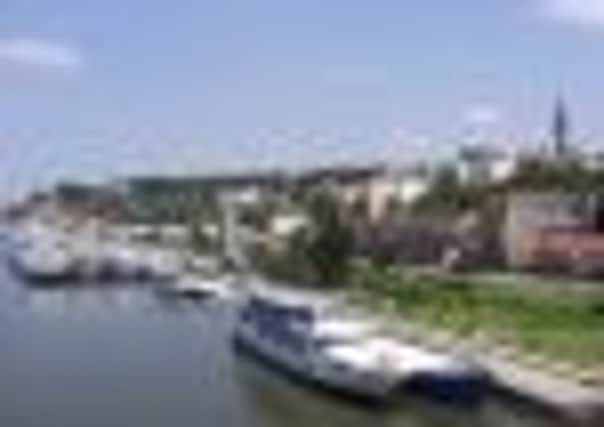Belgrade: Discover the heartbeat of the Balkans


Sadly, the TV and newspaper pictures of the battles in the Balkans are still fresh in the public consciousness. It’s 11 years since NATO forces bombed Belgrade and although Milosevic is long gone, those images still form most people’s knowledge of this part of the world, and to a degree, mine too.
I decided to board a BA plane there because I was fascinated to see just what this city, and south east European country was like at first hand.
Advertisement
Advertisement
What I can tell you is that Belgrade in 2010 is certainly putting its recent troubles behind it. Now it’s looking forward as an energetic, bustling, striking city, a fascinating mix of the modern and traditional.


The river Sava cuts though the city, with the old town rising up the hill on one side and the newer post Second World War part – Novi Beograd – to the other.
You’ll probably want to spend your time in the older section and the first place to start is Trg Republike, (Republic Square). It’s a pedestrian square featuring the imposing National Theatre and filled from dawn till dusk, and well beyond, with shoppers, strollers and those who simply want to while away time chatting in a street cafe/bar – a popular Serbian pastime.
Heading down from here is the car-free boulevard Knez Mihailova, a street of the main designer stores which leads towards arguably Belgrade’s biggest attraction, the fortress – Kalamegdan.
Advertisement
Advertisement
Covering around 60 acres, you can happily spend a few hours exploring the amazingly complete ramparts and towers dating back through the centuries. Sitting astride the top of the hill, it also affords tremendous views of the Sava and Danube rivers below.
Entry to the fortress is absolutely free – but if you wish to part with your Serbian dinars there’s a variety of craft and souvenir stalls including pieces from Communist days and copies of the infamous 50 billion dinar note from Yugoslavia’s days of rampant inflation.
The site also contains the military museum, a detailed if slightly heavyweight look back at the Balkans’ long and eventful history – as well as a natural history museum and zoo.
The biggest figure in the region’s recent history was Josep Tito, war hero and subsequent lifelong charismatic president of Yugoslavia. He died in 1980 – and and his body lies in a mausoleum (Kuca Cveca) a couple of miles south of the centre, together with a collection of gifts presented to him over the decades by world leaders.
Advertisement
Advertisement
I reached the Tito memorial complex via the open tour hop on, hop off tourist bus, which whisks you around the various landmarks in Belgrade (1500rsd/ £13 for 24 hours). The other stunning sight to take in en route is St Sava’s Church, one of the biggest orthodox churches in the world.
Between the Tito complex and St Sava’s Church you’ll find the homes of Belgrade’s two big rival football clubs – Partizan, and the larger Red Star. The latter’s ground is known locally as the Maracana after the vast Brazilian stadium of that name and although the Serbian league is not as strong as in Yugoslavian times gone by, Red Star can still bask in the fact that in 1991 it won the European Cup.
But Belgrade is far more about the atmosphere than the sights. It is a town that likes to enjoy itself – any time, any day of the week. It has a growing reputation as a European clubbing hub and the Sava, in Belgrade and nearby Zemun, is lined with dozens of boats hosting parties into the small hours.
If dining is more your thing, then try Skadarlija – a cobbled avenue close to the centre packed with restaurants, many featuring traditional live Serbian folk music. Portions of local dishes, barbecued meat a particular speciality, or international options are large and cheap, and even in this more touristy area, a meal with drinks can cost all of £10.
Advertisement
Advertisement
Belgrade isn’t beautiful but it’s bubbly and confident – and you feel reassuringly safe wandering around the centre well into the evening. Yes, the street signs in Cyrllic alphabet can have you scratching your head at times but there’s usually somebody who speaks a smattering of English who can help you out. And if you can get your head around the public transport system, the rattling trolley buses, trams and buses will take you around the city at low price.
My base, the Design Hotel Mr President opened in 2007, was well sited close to the train station and a ten minute walk from the old town with top notch facilities and friendly staff. It was one of a clutch of four star hotels in Belgrade – with rooms at a fraction of the prices you’ll pay in western Europe.
Belgrade isn’t on the tourist map for overseas visitors yet – at some venues the attendants can outnumber the visitors at quiet times.
But it’s growing, with the bus tour, a Saturday morning walking tour in English, boat trips and more. There’s cash points and exchange kiosks at every corner and your money will go a long way.
So why not discover Belgrade before the hordes do?
Key facts
Best for: a lively and fascinating city break.
Advertisement
Advertisement
Time to go: spring and autumn – summers can be hot, winters very cold.
Travel facts
BA and JAT Airlines fly daily from London Heathrow to Nikola Tesla Airport, Belgrade www.opodo.co.uk
Wizzair fly from London Luton to Nikola Tesla Airport - www.wizzair.com.
From the airport taxis take 20-30 mins to the centre for 1,200 dinars (£10), bus 72 every 30 mins, taking 45 minutes to central bus stop (Zeleni Venac) for 100 dinars (under £1).
Design Hotel Mr President: Karadjordjeva 75, www.hotelmrpresident.com
Tourist Information at the airport, and in Trg Republike www.tob.co.rs/eng